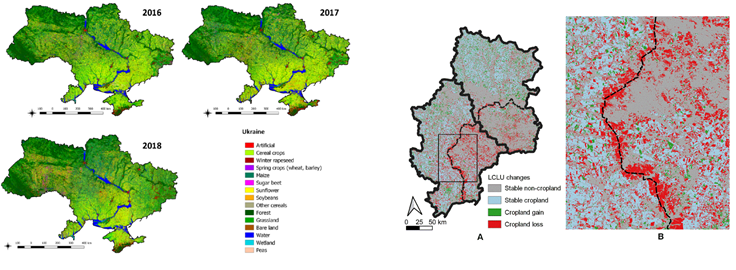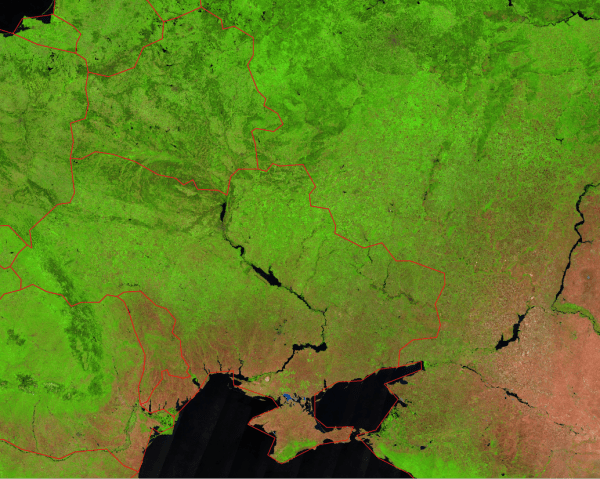Sergii Skakun Receives NASA Grant to Analyze High Impact Hot Spots of Land Cover Land Use Change in Ukraine and Neighboring Countries
Dr. Sergii Skakun, Assistant Professor in the Department of Geographical Sciences and iSchool, received a NASA grant within the Land Cover/ Land Use Change program for the project titled “High-Impact Hot Spots of Land Cover Land Use Change: Ukraine and Neighboring Countries”.
This project is a collaborative effort between GEOG researchers (Dr. Jean-Claude Roger; Dr. Joanne Hall; Dr. Natacha Kalecinski), Ukrainian Space Research Institute (Dr. Nataliia Kussul) and National Technical University of Ukraine “Igor Sikorsky Kyiv Polytechnic Institute” (Dr. Andrii Shelestov).
Project abstract
Since the breakup of the Soviet Union in 1991, Ukraine has been experiencing major changes in land cover and land use (LCLUC). The major drivers for these changes have been continuous economical and policy changes as well as climate variability. In the past 5-7 years, these changes particularly magnified due to the military conflict in the Eastern Ukraine and annexation of Crimea, preparation of the policy to open the land market, conversion to double cropping due to temperature increase and a sharp increase in the production of industrial crops, and continuous practice of burning agricultural fields. All these have led to the LCLUC “hotspots” throughout the country spanning several sectors (agriculture, urban and forestry) and having considerable socio-economic impacts.
Therefore, Ukraine represents a perfect testbed with multiple LCLUC “hotspots” of national and regional importance that have a significant socio-economic impact and are policy relevant. The overall objective of the proposal is to analyze and quantify the impact of LCLUC in Ukraine targeting agricultural, forestry, and urban sectors. We will analyze and quantify on a yearly basis (2013–2022) changes due to the military conflict in Eastern Ukraine. We will develop a methodological framework for crop rotation violation identification and area estimation with a focus on rapeseed and sunflower, and assess the potential environmental impact of not respecting optimal rotations with a focus on SDG goals related to sustainable agriculture and land degradation. We will quantify the area of unregistered (not in the StateGeoCadaster system) agricultural and forestry lands in Ukraine on a yearly basis. We will generate improved crop residue emissions estimates by leveraging both local and satellite-based datasets in combination with expert knowledge of the burning and agricultural practices in Ukraine. The developed methods will be thoroughly validated in Ukraine, and its applicability and robustness will be tested for other regions (Poland and Russia).
The obtained results are expected to have a significant impact on policy, as generated maps and LCLUC quantifications would allow decision-makers and local authorities to gather objective information on processes occurring in conflict-plagued regions in Ukraine and project future relief effort expenses; obtain objective information on land, including those unregistered in the official GeoCadaster system, which is essential for future land markets; enact and improve existing policies related to crop rotation violation and open field burnings.

The activities within this proposal are as follows: (1) data preparation and collection (satellite, in situ, official statistics); (2) development of methods for fusing multi-source satellite data for LCLUC identification and quantification; (3) generation and validation of LCLUC maps for “hotspots” at moderate and very high spatial resolution; (4) analysis and quantification of LCLUC and its impact within a number of use-cases (military conflict, crop rotations, unregistered lands, open burning); (5) demonstration of the robustness of the developed methods for other areas. The main source of remote sensing information will be Landsat-8 (NASA/USGS), Sentinel-2 and Sentinel-1 (EU/Copernicus), MODIS (NASA), VIIRS (NASA/NOAA), Planet/Dove (Planet Labs) and WorldView-3 (DigitalGlobe).
The proposed project will be built on a successful long-term collaboration between US and Ukrainian partners and will leverage results from previous and ongoing projects, including “Crop yield assessment and mapping by a combined use of Landsat-8, Sentinel-2 and Sentinel-1 images” (NASA/LCLUC), “Methodology for SDGs indicators assessment” (GEO-AWS Earth Observation Cloud Credits Program) and “Supporting Transparent Land Governance in Ukraine” (WorldBank).
Published on Mon, 10/26/2020 - 10:42


